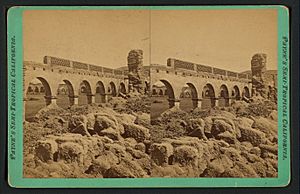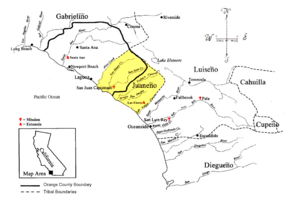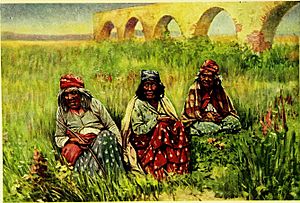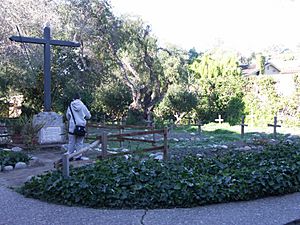Mission Indians facts for kids

Mission Indians are the Native American groups who lived in Southern California. They were moved from their homes and villages to live and work at 15 Spanish missions in Southern California. These missions, along with smaller outposts called Asistencias and Estancias, were built between 1796 and 1823. This happened in the area once known as Las Californias, which was part of New Spain.
Contents
History of the Mission Indians
Spanish explorers first arrived on California's coasts in the mid-1500s. In 1769, the first Spanish Franciscan mission was built in San Diego. Native tribes living nearby were forced to move. They were made to work at the missions. These missions stretched from San Diego all the way to San Francisco.
Life at the missions was very hard for the Native Americans. Many suffered from new diseases, hunger, and too much work. They also faced cruel treatment. Their numbers dropped greatly because of these harsh conditions. Many were baptized as Roman Catholics by the Franciscan missionaries.
The Mission Indians came from many different Native American tribes. Often, people from different tribes were grouped together at the missions. The Spanish then named these groups after the mission they were at. For example, the Payomkowishum people were renamed the Luiseños after the Mission San Luis Rey. The Acjachemem people became the Juaneños after the Mission San Juan Capistrano. The Kizh or Kisiannos were renamed Gabrieleño after the Mission San Gabriel.
Catholic priests at the missions did not allow the Native Americans to practice their own culture. This caused many tribes to lose their languages, spiritual beliefs, and cultural ways. The Native Americans also had no protection against European diseases. Because of these new diseases and difficult living conditions, the Native American population in coastal areas dropped by 90 percent between 1769 and 1848.
When Mexico became independent in 1834, it took control of the California missions from the Franciscans. However, difficult conditions for the Native Americans continued. Mexico then closed down the missions. The mission lands were given or sold to non-Native people. Many Mission Indians then worked on new farms called ranchos. Their living conditions did not get much better.
Around 1906, researchers Alfred L. Kroeber and Constance G. Du Bois from the University of California, Berkeley began using the name "Mission Indians." They used it to describe Native Americans in Southern California, including those from Mission San Luis Obispo de Tolosa and areas further south.
Native American Reservations
On January 12, 1891, the U.S. Congress passed a law to help the Mission Indians in California. This law aimed to protect their rights to land that the Mexican government had originally granted them. It also gave railroad companies certain interests.
In 1927, a government official named Lafayette A. Dorrington was asked to list California tribes. These were tribes for whom Congress had not yet bought land for reservations. As part of a plan in 1928, Native Americans were asked to say which "Tribe or Band" they belonged to. Most people named the mission their ancestors were connected with. This was part of a plan to give them reservation lands. These lands had been promised in 18 non-ratified treaties from 1851–1852.
Because of these applications and their ties to specific mission locations, these groups became known as "mission bands." Some of these bands now live on Indian Reservations. These lands are managed under the Mission Indian Agency. The Mission Indian Act of 1891 created this agency. It oversees reservations in San Diego County, Riverside County, San Bernardino County, and Santa Barbara County. There is one Chumash reservation in Santa Barbara County. There are more than thirty reservations in the other counties.
Los Angeles, San Luis Obispo, Ventura, and Orange counties do not have tribal reservation lands. However, tribes like the Tongva in Los Angeles and the Juaneño-Acjachemen Nation in Orange County are still working to be officially recognized by the U.S. Bureau of Indian Affairs.
Eleven of the Southern California reservations were part of early 1900s programs. These programs divided shared tribal lands into smaller pieces for individual families. Lists like the Dawes Rolls helped identify family heads and tribal members.
Some important reservations include the Agua Caliente Reservation in Palm Springs. It shares land with former railroad grants that make up much of the city. The Morongo Reservation is in the San Gorgonio Pass area. The Pala Reservation includes San Antonio de Pala Asistencia (Pala Mission) from the Mission San Luis Rey de Francia in Pala. These and fifteen other tribal governments now run casinos. The total land area of the Mission Indian reservations is about 250,000 acres (1,000 km2).
Southern California Mission Locations
These Native American tribes were connected to the following Missions, Asisténcias (smaller missions), and Estáncias (ranches):
- Mission San Luis Obispo de Tolosa, in San Luis Obispo
- Mission La Purísima Concepción, northeast of Lompoc
- Mission Santa Inés, in Solvang
- Mission Santa Barbara, in Santa Barbara
- Mission San Buenaventura, in Ventura
- Mission San Fernando Rey de España, in Mission Hills (Los Angeles)
- Mission San Gabriel Arcángel, in San Gabriel
- Mission San Juan Capistrano, in San Juan Capistrano
- Mission San Luis Rey de Francia, in Oceanside
- Mission San Diego de Alcalá, in San Diego
- Santa Ysabel Asistencia, founded in 1818 in Santa Ysabel
- San Antonio de Pala Asistencia (Pala Mission), founded in 1816 in eastern San Diego County
- San Bernardino de Sena Estancia, founded in 1819 in Redlands
- Santa Ana Estancia, founded in 1817 in Costa Mesa
- Las Flores Estancia (Las Flores Asistencia), founded in 1823 in Camp Pendleton
Northern California Mission Locations
In Northern California, specific tribes were also linked to certain missions in their areas:
- Mission Dolores in San Francisco (Muwekma Ohlone)
- Mission San Jose in Fremont (Muwekma Ohlone)
- Mission Santa Clara in Santa Clara/San Jose (Muwekma Ohlone)
- Mission Santa Cruz in Santa Cruz (Amah Mutsun band of Costanoan Ohlone)
- Mission San Juan Bautista in San Juan Bautista (Amah-Mutsun Band of Costanoan Ohlone)
- Mission San Carlos Borromeo de Carmelo in Carmel/Monterey (Esselen nation)
- Mission Nuestra Señora de la Soledad in Soledad (Esselen nation)
- Mission San Antonio de Padua in Jolon (Esselen nation and Salinan nation)
Current Mission Tribes

Here are some of the current Mission Indian tribes in Southern California:
- Agua Caliente Band of Mission Indians (Cahuilla)
- Augustine Band of Mission Indians (Cahuilla)
- Barona Band of Mission Indians (Kumeyaay/Diegueño)
- Cabazon Band of Mission Indians (Cahuilla)
- Cahuilla Band of Mission Indians (Cahuilla)
- Campo Band of Mission Indians (Kumeyaay/Diegueño)
- Capitan Grande Band of Mission Indians (Kumeyaay/Diegueño)
- Cuyapaipe Band of Mission Indians (Kumeyaay/Diegueño)
- Giant Rock Band (unrecognized) of Morongo Serrano-Cahuilla.
- Inaja and Cosmit Band of Mission Indians (Kumeyaay/Diegueño)
- Jamul Band of Mission Indians (Kumeyaay/Diegueño)
- Juaneño Band of Mission Indians (Juaneño)
- Laguna Band of Mission Indians of the Laguna Reservation
- La Jolla Band of Mission Indians (Luiseño)
- La Posta Band of Mission Indians (Kumeyaay/Diegueño)
- Las Palmas Band (unrecognized) of Cahuilla.
- Los Coyotes Band of Mission Indians (Cahuilla and Cupeño)
- Manzanita Band of Mission Indians (Kumeyaay/Diegueño)
- Mesa Grande Band of Mission Indians (Kumeyaay/Diegueño)
- Morongo Band of Mission Indians (Cahuilla, Serrano and Cupeño)
- Pala Band of Mission Indians (Cupeño and Luiseño)
- Pauma Band of Mission Indians (Luiseño)
- Pechanga Band of Mission Indians (Luiseño)
- Ramona Band or Village of Mission Indians (Cahuilla)
- San Cayetano Band (unrecognized) of Cahuilla.
- San Manuel Band of Mission Indians (Serrano)
- San Miguel Arcangel, descendants of Mission San Miguel Indians in San Miguel, California.
- San Pasqual Band of Mission Indians (Kumeyaay/Diegueño)
- Santa Rosa Band of Mission Indians (Cahuilla)
- Santa Ynez Band of Mission Indians (Chumash)
- Santa Ysabel Band of Mission Indians (Kumeyaay/Diegueño)
- Soboba Band of Mission Indians (Luiseño)
- Sycuan Band of Mission Indians (Kumeyaay/Diegueño)
- Temecula Band (unrecognized) of Mission Indians (Luiseño and Serrano).
- Torres-Martinez Band of Mission Indians (Cahuilla)
- Twenty-Nine Palms Band of Mission Indians (Chemehuevi with some Cahuilla and Luiseño descent)
Other Mission Indian tribes are found north of these groups. They are in the Los Angeles Basin, Central Coast, Salinas Valley, Monterey Bay, and San Francisco Bay Area. These tribes were also linked to the local missions in their regions.



